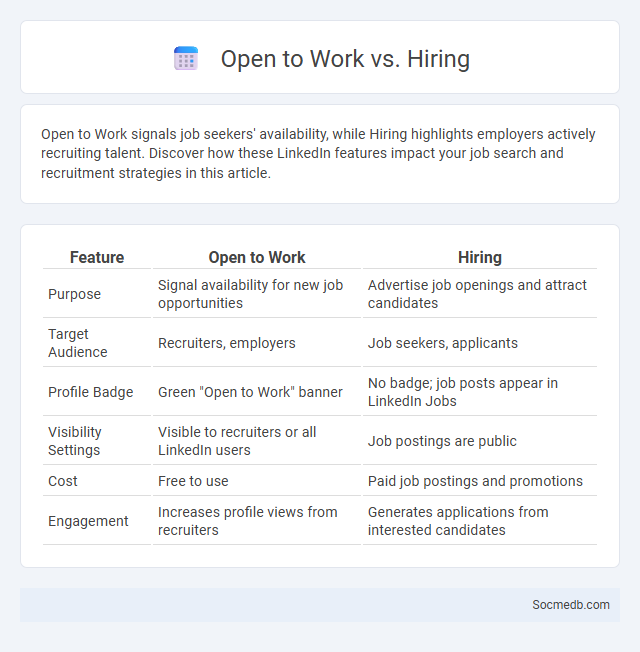
Photo illustration: Open to Work vs Hiring
Open to Work signals job seekers' availability, while Hiring highlights employers actively recruiting talent. Discover how these LinkedIn features impact your job search and recruitment strategies in this article.
Table of Comparison
| Feature | Open to Work | Hiring |
|---|---|---|
| Purpose | Signal availability for new job opportunities | Advertise job openings and attract candidates |
| Target Audience | Recruiters, employers | Job seekers, applicants |
| Profile Badge | Green "Open to Work" banner | No badge; job posts appear in LinkedIn Jobs |
| Visibility Settings | Visible to recruiters or all LinkedIn users | Job postings are public |
| Cost | Free to use | Paid job postings and promotions |
| Engagement | Increases profile views from recruiters | Generates applications from interested candidates |
Understanding LinkedIn Badges: Open to Work, Hiring, and Job Seeking
LinkedIn badges such as Open to Work, Hiring, and Job Seeking enhance profile visibility by signaling professional status and intentions to recruiters and connections. The Open to Work badge indicates active job seekers, while the Hiring badge helps employers attract potential candidates by showcasing job openings. Utilizing these badges effectively increases networking opportunities and accelerates talent acquisition within the LinkedIn platform.
What Does the “Open to Work” Badge Communicate?
The "Open to Work" badge on social media platforms like LinkedIn communicates a clear signal to recruiters and professional networks that an individual is actively seeking new job opportunities. This badge enhances profile visibility by categorizing users as open candidates, thus attracting targeted job inquiries and networking offers. Incorporating this status increases engagement from employers and industry contacts, facilitating quicker connections in competitive job markets.
The Role of the “Hiring” Badge in Employer Branding
The "Hiring" badge on social media platforms like LinkedIn and Facebook plays a crucial role in enhancing employer branding by visibly signaling a company's recruitment efforts to a broad audience. This badge increases company visibility in job searches, attracts passive candidates, and fosters trust by showcasing active growth and opportunity. Organizations leveraging the "Hiring" badge experience higher engagement rates, improved candidate quality, and strengthened brand perception in competitive talent markets.
The Impact of the “Job Seeking” Badge on Candidate Visibility
The "Job Seeking" badge on social media platforms significantly enhances candidate visibility by signaling active job search status to recruiters and employers, increasing profile views by up to 40%. This badge leverages algorithmic prioritization, pushing candidates higher in search results and recommendation feeds, thereby improving engagement rates. Studies show profiles with this badge receive 2.5 times more direct contact from hiring managers compared to profiles without it.
Advantages of Using Open to Work Badge for Job Seekers
Displaying the Open to Work badge on social media profiles increases visibility among recruiters, enhancing job seekers' chances of receiving relevant opportunities. This feature signals active job readiness, attracting targeted job offers and networking connections in specific industries. Leveraging the badge can accelerate the job search process by connecting candidates to roles aligned with their skills and career goals.
How Hiring Badge Attracts Top Talent to Organizations
Displaying a Hiring Badge on your social media profile instantly signals that your organization is actively recruiting, increasing visibility among qualified candidates. This targeted attraction draws top talent by showcasing your commitment to growth and openness to new opportunities. Leveraging a Hiring Badge amplifies your employer brand, setting your organization apart in competitive job markets.
Potential Drawbacks of Displaying Job Seeking Badges Publicly
Displaying job-seeking badges publicly on social media can signal active employment gaps or desperation, potentially diminishing professional image in the eyes of recruiters and peers. Public badges may invite unsolicited contact or spam from recruiters and scams, compromising the user's privacy and online security. Employers might interpret visible job-seeking signals as lower job satisfaction or instability, influencing hiring decisions negatively.
Optimizing Profile Settings for Each LinkedIn Badge
Optimizing profile settings for each LinkedIn badge increases your visibility and credibility within your professional network. Tailor your headline, summary, and featured content to highlight specific skills or achievements that align with the badge's focus, ensuring Your profile stands out to recruiters and industry peers. Regular updates and strategic keyword integration enhance searchability and reinforce your expertise across LinkedIn's platform.
Best Practices: Choosing the Right Badge for Your LinkedIn Goals
Selecting the optimal LinkedIn badge enhances your profile's credibility and aligns with your professional objectives by clearly showcasing your skills, certifications, or affiliations. Tailor your badge choice to reflect industry relevance, ensuring it resonates with your target audience and supports your networking and job search strategies. Consistently updating badges to highlight recent achievements maintains profile dynamism and maximizes engagement within LinkedIn's professional community.
Open to Work vs Hiring vs Job Seeking: Which Badge Drives Results?
Open to Work badges on LinkedIn increase visibility to recruiters by 40%, boosting job seeker engagement more than generic job-seeking statuses. Hiring badges optimize employer branding, attracting 30% more qualified applicants compared to non-badged postings. Data shows that explicit Open to Work signals yield a 25% higher interview rate, making them the most effective badge for job seekers aiming to drive tangible hiring results.
 socmedb.com
socmedb.com